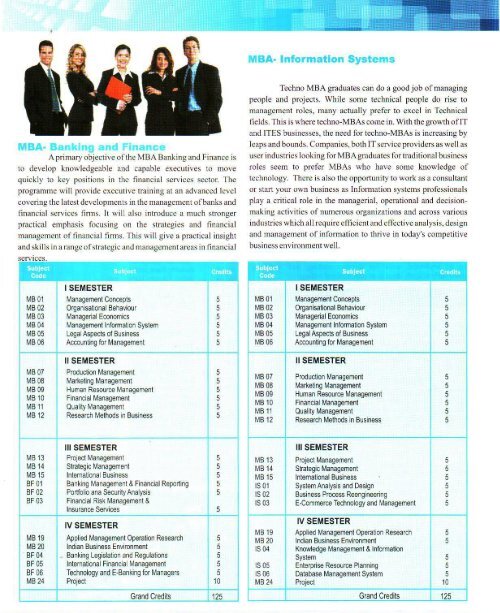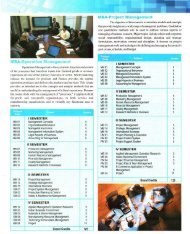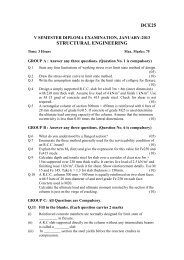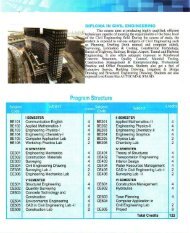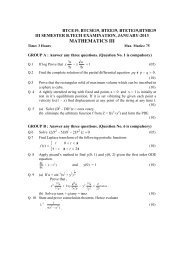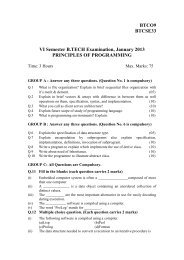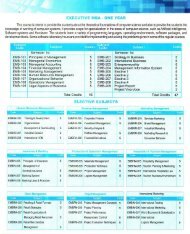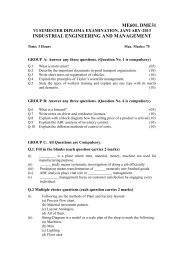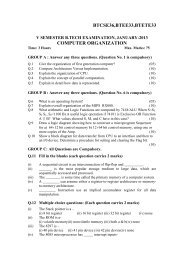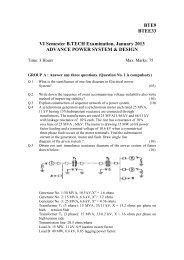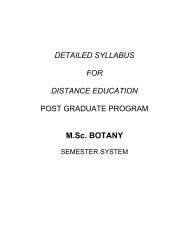MBA in Banking & Finance
MBA in Banking & Finance
MBA in Banking & Finance
You also want an ePaper? Increase the reach of your titles
YUMPU automatically turns print PDFs into web optimized ePapers that Google loves.
<strong>MBA</strong>- Bank<strong>in</strong>g and F<strong>in</strong>anceA primary objective of the <strong>MBA</strong> Bank<strong>in</strong>g and F<strong>in</strong>ance is to develop knowledgeable and capableexecutives to move quickly to key positions <strong>in</strong> the f<strong>in</strong>ancial services sector. The programme will provideexecutive tra<strong>in</strong><strong>in</strong>g at an advanced level cover<strong>in</strong>g the latest developments <strong>in</strong> the management of banks andf<strong>in</strong>ancial services firms. It will also <strong>in</strong>troduce a much stronger practical emphasis focus<strong>in</strong>g on the strategies andf<strong>in</strong>ancial management of f<strong>in</strong>ancial firms. This will give a practical <strong>in</strong>sight and skills <strong>in</strong> a range of strategic andmanagement areas <strong>in</strong> f<strong>in</strong>ancial services.SubjectCodeSubjectCreditsSubjectCodeSubjectCreditsSEMESTER I<strong>MBA</strong>-01SEMESTER IIIManagerial Tasks and BehaviouralDynamics 5 <strong>MBA</strong>-13 Research Methodology 5<strong>MBA</strong>-02Corporate Communication andManagerial Economics 5 <strong>MBA</strong>-14 Total Quality Management 5<strong>MBA</strong>-03<strong>MBA</strong>-04Legislative Framework of Bus<strong>in</strong>ess5 <strong>MBA</strong>-15Account<strong>in</strong>g and Taxation forManagers 5 BF-01International Bus<strong>in</strong>ess5ManagementBank<strong>in</strong>g Management andF<strong>in</strong>ancial Report<strong>in</strong>g 5<strong>MBA</strong>-05Quantitative Techniques forManagerial Decisions 5 BF-02Portfolio and Security Analysis5<strong>MBA</strong>-06Bus<strong>in</strong>ess Development andEntrepreneurship5 BF-03F<strong>in</strong>ancial Risk Managementand Insurance Services 5SEMESTER IISEMESTER IV<strong>MBA</strong>-07Human Asset Management5 BF-04Bank<strong>in</strong>g Legislation andRegulations 5<strong>MBA</strong>-08Corporate F<strong>in</strong>ance and Services5 BF-05International F<strong>in</strong>ancialManagement 5<strong>MBA</strong>-09<strong>MBA</strong>-10Market<strong>in</strong>g Plann<strong>in</strong>g andManagement 5 BF-06Production Technology andIndustrial Eng<strong>in</strong>eer<strong>in</strong>g 5 BF-07Technology and E- Bank<strong>in</strong>g forManagers 5F<strong>in</strong>ancial Institutions andServices Management 5<strong>MBA</strong>-11 Information Science for Managers 5 BF-08<strong>MBA</strong>-12Strategic Management andCorporate Governance5 <strong>MBA</strong>-16F<strong>in</strong>ancial Inclusion and SocialBank<strong>in</strong>gProject WorkViva-Voice563Grand Credits 124
SUBJECT CODE: <strong>MBA</strong>-01SUBJECT: MANAGERIAL TASKS AND BEHAVIOURAL DYNAMICSThis course helps to prepare the students to understand the basic application of managerial functions <strong>in</strong>day to day operations and activities of corporate and bus<strong>in</strong>ess enterprises.OBJECTIVES:1. To understand the role and responsibilities of manager2. To learn the process of management <strong>in</strong> corporate enterprises.3. To comprehend the behavior of others and adapt to managerial success.4. To make the students to equip the necessary changes and developments <strong>in</strong> an organization.STRUCTURE OF THE COURSE CONTENTBLOCK 1 MANAGERIAL FUNCTION AND RESPONSIBILITIESUnit 1: Manager Role, Responsibilities and TasksUnit 2: Managerial Functions and Their CharacteristicsUnit 3: Evolution of Management and Schools of ThoughtUnit 4: Social Responsibilities and Bus<strong>in</strong>ess Ethics & Corporate GovernanceBLOCK 2 PLANNING AND ORGANIZING FUNCTIONUnit 1: Plann<strong>in</strong>g Nature, Types and ProcessUnit 2: Decision Mak<strong>in</strong>g and MBOUnit 3: Organiz<strong>in</strong>g Pr<strong>in</strong>ciples and Structural DesignUnit 4: Delegation, Span of Control, Decentralization, L<strong>in</strong>e and Staff AuthorityBLOCK 3 DIRECTING, CONTROLLING AND CO ORDINATIONUnit 1: Direct<strong>in</strong>g, Motivat<strong>in</strong>g, And LeadershipUnit 2: Controll<strong>in</strong>g Nature and TechniquesUnit 3: Co Ord<strong>in</strong>ation the Essence of ManagementUnit 4: Contemporary Trends <strong>in</strong> ManagementBLOCK 4 INTRODUCTIONS TO BEHAVIOURAL DYNAMICSUnit 1: Evolution, Challenges and Opportunities of Organization BehaviourUnit 2: Personality and Behavioural AssessmentUnit 3: Emotions and Learn<strong>in</strong>gUnit 4: Perceptions and Stress ManagementBLOCK 5 ORGANIZATIONAL BEHAVIOURAL DYNAMICSUnit 1: Change ManagementUnit 2: Organizational ClimateUnit 3: Management of ConflictsUnit 4: Organizational Development InterventionsREFERENCE BOOKS:1. Peter F Druker, Management Tasks and Responsibilities, Truman Talley Books, New York.2. Stephen P Robb<strong>in</strong>s, Fundamental of Management, Pearson 20033. Koontz & Weirich, Essentials of Management, Tata McGraw Hill, New Delhi4. Stephen P Robb<strong>in</strong>s, Organization Behaviour, Prentice Hall Of India, 6 th Edition5. C B Gupta, Management Pr<strong>in</strong>ciples And Practice, Sultan Chand & Sons, New Delhi6. L M Prasad, Organization Behaviour, Sultan Chand & Sons, New Delhi7. Consumer Behaviour- Leon Schiffman, Lesslie Lazar Kanuk-Pearson/PHI,8/E8. Consumer Behaviour- Hawk<strong>in</strong>s, Best, Coney-TMH,9/e,20049. Consumer Behaviour <strong>in</strong> Indian Perspective – Suja Nair – Himalaya Publishers, 200410. Consumer Behaviour- Satish k Batra & S H H Kazmi, Excell Books11. Customer Relationship Management- Peeru Ahamed & Sagadevan Vikas Publish<strong>in</strong>g
5. Bus<strong>in</strong>ess Communication - Asha Kaul (2000), New Delhi, Prentice Hall of India6. Effective Bus<strong>in</strong>ess Communication - Murphy and Hildebrandt (1991),New York: McGraw Hill7. Communication <strong>in</strong> India : Some Observations and Theoreticalimplications - J.S. Yadava, IIMC8. Communication Theory: Eastern and Western perspective- Lawrence D.
SUBJECT CODE: <strong>MBA</strong>-03SUBJECT: LEGISLATIVE FRAMEWORK OF BUSINESSThis course presents the rules and conduct of bus<strong>in</strong>ess <strong>in</strong> terms of legislative framework. This studyhelps the manager to lead the bus<strong>in</strong>ess <strong>in</strong> a smooth and orderly manner as per the legal prescription by theIndian Government.OBJECTIVES1. To understand the nature of laws govern<strong>in</strong>g the Indian bus<strong>in</strong>ess.2. To understand the economic and labour laws perta<strong>in</strong><strong>in</strong>g to corporate perspectives.3. To govern the bus<strong>in</strong>ess as per the legislative requirements.4. To exam<strong>in</strong>e the recent requirements of the government from the bus<strong>in</strong>ess.STRUCTURE OF THE COURSE CONTENTBLOCK 1 ELEMENTS OF BUSINESS LEGISLATIONUnit 1: The Contract Act 1872, And Their Special ContractsUnit 2: Indian Partnership Act 1932Unit 3: Sale of Goods Act 1930Unit 4: Negotiable Instruments Act 1881BLOCK 2 ELEMENTS OF ECONOMICS LEGISLATIONUnit 1: Information Technology Act 2000Unit 2: The Consumer Protection Act 1986Unit 3: The Environment Protection Act 1986Unit 4: Competition Law 2002Unit 5: Intellectual Property Tax LawsBLOCK 3 BANKING AND INSURANCE LAWSUnit 1: The Bank<strong>in</strong>g Regulation Act 1949Unit 2: The Reserve Bank of India Act 1934Unit 3: The Insurance Act and IRDA RegulationsBLOCK 4 LABOUR LEGISLATIONUnit 1: Factories Act 1948 & Workmen Compensation Act 1923Unit 2: Employee State Insurance Act 1948 & EPF and MiscellaneousProvisio`n Act 1952Unit 3: Industrial Disputes Act 1947 & Trade Union Act 1926Unit 4: The M<strong>in</strong>imum Wages Act 1948 & the Payment of Wages Act 1936Unit 5: The Payment Of Bonus Act 1965 & The Payment Of Gratuity Act 1972.BLOCK 5 CORPORATE LEGISLATIONUnit 1: The Indian Companies Act 1956Unit 2: The Securities Contracts and Regulation Act 1956Unit 3: sebi rulesREFERENCE BOOKS1. N D kapoor, elements of merchantile law, sultan chand & sons, New Delhi.2. Essential bare acts3. Majumdar, G k kapoor, corporate laws and secretarial practice, taxmann publication, new delhi4. M tannan, bank<strong>in</strong>g law and practice,5. Bus<strong>in</strong>ess Law – S.S. Gulshan
6. Saravanavel & Sumathi- Bus<strong>in</strong>ess Law for Management – HPH7. M C Kuchhal -Bus<strong>in</strong>ess Law -Vikas, 4/e, 20058. BARE ACTS -Indian Contract Act 1872Negotiable Instruments Act 1881Indian Partnership Act 1932Foreign Exchange Management Act 1999Sale Of Goods Act 1930Consumer Protection Act 1986Information Technology Act 2000Companies Act 1956Environmental Protection Act 1986Right To Information Act
SUBJECT CODE: <strong>MBA</strong>-04SUBJECT: ACCOUNTING AND TAXATION FOR MANAGERSThis course enables the students to acqua<strong>in</strong>t the knowledge of application of account<strong>in</strong>g and f<strong>in</strong>ancialprocess of organization framework. It also enables to assess and evaluate the f<strong>in</strong>ancial results for futureorganization.OBJECTIVES1. To understand the basic ideology of record<strong>in</strong>g, classify<strong>in</strong>g and summariz<strong>in</strong>g f<strong>in</strong>ancial records.2. To assess and diagnose the f<strong>in</strong>ancial condition and position of bus<strong>in</strong>ess results.3. To apply the cost<strong>in</strong>g and managerial tools and techniques for decision mak<strong>in</strong>g.4. To ensure the tax laws govern<strong>in</strong>g the bus<strong>in</strong>ess condition<strong>in</strong>g and regulation.STRUCTURE OF THE COURSE CONTENTBLOCK 1 BASIC ACCOUNTING CONCEPTS AND PRINCIPLESUnit 1: Account<strong>in</strong>g Pr<strong>in</strong>ciples and TheoryUnit 2: Indian Account<strong>in</strong>g StandardsUnit 3: Users of Account<strong>in</strong>g Information and Account<strong>in</strong>g EquationUnit 4: Double Entry Pr<strong>in</strong>ciples – Journal, Subsidiary Books,Ledger and Trial BalanceBLOCK 2 FINANCIAL STATEMENTS ANALYSISUnit 1: F<strong>in</strong>ancial Statements – Corporate and Non Corporate BodiesUnit 2: F<strong>in</strong>ancial Statement Analysis and Ratio AnalysisUnit 3: Funds Flow and Cash Flow AnalysisBLOCK 3 COST ACCOUNTINGUnit 1: Elements of Cost and Cost StatementUnit 2: Marg<strong>in</strong>al Cost<strong>in</strong>g and Break Even AnalysisUnit 3: Budget<strong>in</strong>g and Budgetary TechniquesUnit 4: Standard Cost<strong>in</strong>g and Variance AnalysisBLOCK 4 MANAGEMENT ACCOUNTINGUnit 1: Long Term Investment AppraisalUnit 2: Cost<strong>in</strong>g For Decision Mak<strong>in</strong>gUnit 3: Process and Service Cost<strong>in</strong>gUnit 4: Responsibility Account<strong>in</strong>g and Transfer Pric<strong>in</strong>gBLOCK 5 TAXATION FOR MANAGEMENTUnit 1: Taxation Pr<strong>in</strong>ciples and SystemUnit 2: Direct Taxation: The Income Tax Act 1961 and Wealth Tax ActUnit 3: Indirect Taxation: Central Excise, Central Customs and Sales Tax ActUnit 4: service taxRECOMMENDEND TEXT BOOKS1. M C Shukla, T S Grewal, S C Gupta, Advanced Accounts, Sultan Chand & Company, New Delhi2. Saxena & Vashist, Cost and Management Account<strong>in</strong>g, Sultan Chand & Sons, New Delhi3. S P Ja<strong>in</strong> and K L Narang Advanced Accountancy, Kalyani Publishers, New Delhi.4. V<strong>in</strong>od K S<strong>in</strong>ghania, Kapil S<strong>in</strong>ghania, Direct Tax Laws, Tax Mann Publications,5. V S Datey, Indirect Taxation, Taxmann Publications. New Delhi.6. Cost Account<strong>in</strong>g - Khan & Ja<strong>in</strong>7. Management Account<strong>in</strong>g 3rd Ed. - Khan & Ja<strong>in</strong>8. Theory & Problems <strong>in</strong> Management & Cost Account<strong>in</strong>g - Khan & Ja<strong>in</strong>9. Cost Account<strong>in</strong>g - Jawaharlal
SUBJECT CODE: <strong>MBA</strong>-06SUBJECT: BUSINESS DEVELOPMENT AND ENTREPRENEURSHIPThe purpose of this course is to provide a strong theoretical framework for bus<strong>in</strong>ess <strong>in</strong>novation,development and growth issues for <strong>in</strong>itiation of new bus<strong>in</strong>ess ideas. It also helps to develop the skills to start anew venture and becomes entrepreneur <strong>in</strong> future career.OBJECTIVES:1. To prepare a groundwork for bus<strong>in</strong>ess creation, development and <strong>in</strong>itiation.2. To build the necessary caliber and competencies for runn<strong>in</strong>g and conduct<strong>in</strong>g new bus<strong>in</strong>ess.3. To help the students to prepare desirable and feasible project report for bus<strong>in</strong>ess project.4. To create new ideas for successful entrepreneurship and launch<strong>in</strong>g technical know how <strong>in</strong> a pragmaticbus<strong>in</strong>ess application.STRUCTURE OF THE COURSE CONTENTBLOCK I BUSINESS INNOVATION AND CREATIVITYUnit 1: Skills and Styles of Innovation and CreativityUnit 2: Creative OrganizationUnit 3: Functional InnovationUnit 4: Personal Innovation and Self Awareness PlanBLOCK II ENTREPRENEURSHIPUnit 1: Role and Functions of EntrepreneursUnit 2: Entrepreneurial Competencies and CultureUnit 3: Entrepreneurial Motivation and PerformanceUnit 4: Women and Social EntrepreneurshipBLOCK III BUSINESS IDEASUnit 1: Sources of Bus<strong>in</strong>ess IdeasUnit 2: Bus<strong>in</strong>ess Plann<strong>in</strong>g and Measurement of SuccessUnit 3: Commencement of Internet Bus<strong>in</strong>essUnit 4: Presentation of Feasibility ReportBLOCK IV ENTREPRENEURIAL TRANSITITONSUnit 1: Entrepreneurial Growth and Management StructureUnit 2: Legal and Intellectual Property IssuesUnit 3: Venture Capital and Entrepreneurial F<strong>in</strong>anceUnit 4: Crisis and Symptoms of Bus<strong>in</strong>ess FailuresBLOCK V INSTIUTIONAL FRAMEWORK OF ENTREPRENEURUnit 1: Role of Government for Promotion of EntrepreneurUnit 2: Agencies for Entrepreneurship DevelopmentUnit 3: Turnaround Strategies and Rehabilitation MeasuresUnit 4: Global EntrepreneurshipREFERENCE BOOKS:1. Bellon Whitt<strong>in</strong>gton, “Compet<strong>in</strong>g Through Innovation”, Prentice.2. Peter F Drucker, “Innovation and Entrepreneurship”3. Vasant Desia, Management of Small Scale Enterprise, Himalaya Publish<strong>in</strong>g House, New Delhi.4. J C Verma and Gurpal S<strong>in</strong>gh, Small Bus<strong>in</strong>ess and Industry – A Handbook for Entrepreneurs, SagePublications, New Delhi.5. Brandt, Steven C., The 10 Commandments for Build<strong>in</strong>g a Growth Company, ThirdEdition,Macmillan Bus<strong>in</strong>ess Books, Delhi, 1977
6. Bhide, Amar V., The Orig<strong>in</strong> and Evolution of New Bus<strong>in</strong>esses, Oxford University Press, NewYork, 2000.7. Desai, Vasant, Small Scale Enterprises Vols. 1-12, Mumbai, Himalaya Publish<strong>in</strong>g House. (Latestedition).8. Doll<strong>in</strong>ger, Mare J., Entrepreneurship: Strategies and Resources, Ill<strong>in</strong>ois, Irw<strong>in</strong>,1955.9. Holt, David H., Entrepreneurship: New Venture Creation, Prentice-Hall of India,New Delhi, latestEdition.
SUBJECT CODE: <strong>MBA</strong>-07SUBJECT: HUMAN ASSET MANAGEMENTThis course will help the students to explore, recognize and analyse the multiple paradoxes related tothe study and application of human resource as an asset <strong>in</strong> an organization. This course will help the students tounderstand the basic nature, functions, activities, operations and complexities of human resource management <strong>in</strong>the corporate realm.OBJECTIVES:1. To <strong>in</strong>troduce conceptual and theoretical foundations of human resource management.2. To aware the importance of human and recognize as an asset <strong>in</strong> an organization.3. To acquire the skills of <strong>in</strong>teraction and execution of managerial duties with the help of humanresources.4. To understand the values and utilities of human resources <strong>in</strong> an competitive environment.STRUCTURE OF THE COURSE CONTENTBLOCK 1: HUMAN RESOURCE – INTRODUCTORY PERCEPTIONUnit 1: Human resource management – concept, scope, objectives,philosophy and trendsUnit 2: Functions organization and environment of human resource managementUnit 3: HRM models, theories, approaches and fish bone diagram approachBLOCK 2: PROCUREMENT AND ACQUISITION OF HUMANRESOURCESUnit 1: Human Resource Plann<strong>in</strong>g, Inventory and Forecast<strong>in</strong>g TechniquesUnit 2: Job Analysis and Employment SecurityUnit 3: Recruitment, Selection, Placement, Induction and SocializationBLOCK 3: DEVELOPMENTS OF HUMAN RESOURCESUnit 1: Employee Tra<strong>in</strong><strong>in</strong>gUnit 2: Executive Development and Managerial GrowthUnit 3: Career Plann<strong>in</strong>g and ManagementUnit 4: Promotion, Transfer and SeparationUnit 5: Performance Appraisal and Merit Rat<strong>in</strong>gBLOCK 4: WAGES AND SALARIES ADMINISTRATIONUnit 1: Theory of wages and job evaluationUnit 2: Pay plans and executive compensationUnit 3: Performance and f<strong>in</strong>ancial <strong>in</strong>centivesUnit 4: Benefits and services and employee commitmentBLOCK 5 : MAINTENANCE OF HUMAN RESOURCESUnit 1: Discipl<strong>in</strong>e Adm<strong>in</strong>istration, Grievances and Industrial RelationsUnit 2: Collective Barga<strong>in</strong><strong>in</strong>g and Trade UnionismUnit 3: Employee Health, Safety and Security Welfare MeasuresUnit 4: Human Resource Audit, Account<strong>in</strong>g, Report and Information SystemUnit 5: Human Resource EmpowermentREFERENCE BOOKS1. David A Decenzo & Stephen P Robb<strong>in</strong>s, Personnel/Human Resource Management, Prentice Hall ofIndia Ltd. Pearson.2. N G Nair & Latha Nair, Personnel Management and Industrial Relations, Sultan Chand And CompanyNew Delhi.
SUBJECT CODE: <strong>MBA</strong>-09SUBJECT: MARKETING PLANNING AND MANAGEMENTThis course presents the ideas of understand<strong>in</strong>g market, market<strong>in</strong>g, market<strong>in</strong>g plann<strong>in</strong>g, organiz<strong>in</strong>g andcontroll<strong>in</strong>g aspects <strong>in</strong> the current scenario. This study helps the modern marketers to arrange the resourcesstrategically accord<strong>in</strong>g to chang<strong>in</strong>g market<strong>in</strong>g needs and requirements.OBJECTIVES:1. To understand the fundamental concepts and approaches of market<strong>in</strong>g2. To learn the buyer behavior and market<strong>in</strong>g segmentation3. To familiarize the 4p’s <strong>in</strong> market<strong>in</strong>g system4. To learn about the market and market<strong>in</strong>g analysis.STRUCTURE OF THE COURSE CONTENTSBLOCK 1 MARKETING CONCEPTS AND TASKSUnit 1: Customer value satisfaction and market<strong>in</strong>g tasksUnit 2: Digitalization, customization and e market<strong>in</strong>gUnit 3: Market and market<strong>in</strong>g research and <strong>in</strong>formation systemUnit 4: Concept, approaches and functions of market<strong>in</strong>gBLOCK 2 MARKETING STRATEGIC PLANNINGUnit 1: Market<strong>in</strong>g Action PlansUnit 2: Strategic Market<strong>in</strong>g ProcessUnit 3: Market<strong>in</strong>g Audit and Evaluation SystemUnit 4: Market<strong>in</strong>g Models and Competitor AnalysisBLOCK 3 MARKETING PROGRAMMESUnit 1: Consumer BehaviorUnit 2: Market<strong>in</strong>g SegmentationUnit 3: Services Market<strong>in</strong>gUnit 4: Market<strong>in</strong>g Ethics and LegislationBLOCK 4 PRODUCT MANAGEMENTUnit 1: Mean<strong>in</strong>g policy and development of productUnit 2: Product l<strong>in</strong>e strategyUnit 3: Product identification brand<strong>in</strong>g and packag<strong>in</strong>gUnit 4: Pric<strong>in</strong>g of productsBLOCK 5 MARKETING COMMUNICATION MANAGEMENTUnit 1: Sales Promotion Tools and TechniquesUnit 2: Advertis<strong>in</strong>gUnit 3: Management of physical distributionUnit 4: Sales force managementREFERENCE BOOKS1. Philip Kotler, Market<strong>in</strong>g Management Analysis, Plann<strong>in</strong>g and Control, Prentice Hall.2. Guiltman J P & Gordon W P , Market<strong>in</strong>g Management Strategies & Programmes, Mc Graw Hill, NewYork.3. Ramasamy & Namakumari, Market<strong>in</strong>g Management Plann<strong>in</strong>g, Control And Implementation,Macmillan India4. SA Sherleker, Market<strong>in</strong>g Management, Vikas Publications.5. S Jayachandran, Market<strong>in</strong>g Management, Tata Mc Graw Hill, 2003.
6. Border, N.H. and: Advertis<strong>in</strong>g Management-Text and Cases,Marshal, W.V Richard D. Irw<strong>in</strong> Inc. 1967.7. Howard. J.M. : Consumer Behaviour <strong>in</strong> Market<strong>in</strong>g Strategies, Prentice Hall, 1989.8. Montegomery, D.B.: Management Science <strong>in</strong> Market<strong>in</strong>g,& Urban. G.L. Prentice Hall, 197
SUBJECT CODE: <strong>MBA</strong>-10SUBJECT: PRODUCTION TECHNOLOGY AND INDUSTRIAL ENGINEERINGThis course focuses on basic managerial issues aris<strong>in</strong>g <strong>in</strong> the production and operations of bothmanufactur<strong>in</strong>g and service <strong>in</strong>dustries. The objectives are to familiarize students with the problems and issuesconfront<strong>in</strong>g production technology managers and to <strong>in</strong>troduce language, conceptual models, and analyticaltechniques that are broadly applicable <strong>in</strong> confront<strong>in</strong>g such problems.OBJECTIVES:1. To address rapid changes <strong>in</strong> technology application to production and <strong>in</strong>dustrial eng<strong>in</strong>eer<strong>in</strong>gmanagement2. To focus on some fundamental concepts and techniques of production system3. To provide some significant background of pragmatic implementation of technology <strong>in</strong> managerialdecision mak<strong>in</strong>g.4. To emphasize the theory of work design, product development, order delivery and customerservice through by bus<strong>in</strong>ess process.STRUCTURE OF THE COURSE CONTENTBLOCK 1: TECHNOLOGY OF PRODUCTION TECHNIQUESUnit 1: Mean<strong>in</strong>g and implication of technologyUnit 2: Technology forecast<strong>in</strong>gUnit 3: Mach<strong>in</strong>e tools process technologyUnit 4: FMS, JIT, MRP –I, MRP-II and advanced techniquesBLOCK 2: PRODUCTION PLANNINGUnit 1: Integrated Production Plann<strong>in</strong>g SystemUnit 2: Procurement Plann<strong>in</strong>g and Inventory PolicyUnit 3: Schedul<strong>in</strong>g and OptimizationUnit 4: Production Monitor<strong>in</strong>g SystemBLOCK 3: PRODUCTION DESIGN AND ECONOMICSUnit 1: Facilities Location and LayoutUnit 2: Capacity and Work System DesignUnit 3: Management Information System for Production TechnologyUnit 4: Ma<strong>in</strong>tenance and Waste ManagementBLOCK 4: PRODUCTIVITYUnit 1: Measurement of productivityUnit 2: Work study and sampl<strong>in</strong>gUnit 3: Cost reduction and value analysisUnit 4: Cost and f<strong>in</strong>ancial impact of operational activitiesBLOCK 5: INDUSTRIAL ENGINEERINGUnit 1: Quality assuranceUnit 2: Methods of eng<strong>in</strong>eer<strong>in</strong>g and ergonomicsUnit 3: Manufactur<strong>in</strong>g AutomationUnit 4: Materials Handl<strong>in</strong>gUnit 5: Stores and Purchase ManagementREFERENCE BOOKS1. Adam & Ebert, Production and Operation Management, Prentice Hall2. Op Khanna, Industrial Eng<strong>in</strong>eer<strong>in</strong>g And Management,Dhanbat Rai & Sons, New Delhi
3. T Hill, Production/Operation Managemnet, Prentice Hall, London4. Berk J and Berk S, Total Quality Management, Implement<strong>in</strong>g Cont<strong>in</strong>uous Improvement, Excel Books,New Delhi.5. Chary S N, Production and Operation Management, Tata Mcgraw Hill, New Delhi.6. Willie Harruner, Occupational Safety Management and Eng<strong>in</strong>eer<strong>in</strong>g, latest edition. Prentice-Hall. ISBN0-13-629437-5.7. M.S. Sanders, Human Factors <strong>in</strong> Eng<strong>in</strong>eer<strong>in</strong>g and Design, 7th Edition. McGraw-Hill, 1993.8. R.S. Bridger, Introduction to Ergonomic. McGraw-Hill, ISBN 0-07-007741-X.9. Laudon & Laudon, Management Information Systems: A Comtemporary Perspective, latest edition.MacMillan, 1991.
SUBJECT CODE: <strong>MBA</strong>-11SUBJECT: INFORMATION SCIENCE FOR MANAGERSThe purpose of this course is to present the fundamentals of the computer, data process<strong>in</strong>g techniques,and concepts of e mail, e commerce and tele work<strong>in</strong>g. It helps the modern manager to process bus<strong>in</strong>essapplications <strong>in</strong> payroll generation, bill generation, e commerce and e communication or complicateddecision mak<strong>in</strong>g <strong>in</strong> computerized environment.OBJECTIVES:1. To know the development of computer & communication technology and its application <strong>in</strong>managerial decision mak<strong>in</strong>g.2. To learn the concept and need of system development <strong>in</strong> managerial work3. To understand the impact of <strong>in</strong>formation technology <strong>in</strong> corporate environment.4. To assess the changes and requirements of bus<strong>in</strong>ess appraisal <strong>in</strong> terms of <strong>in</strong>formation technology.STRUCTURE OF THE COURSE CONTENTBLOCK 1: COMPUTER SYSTEMUnit 1: Computer and data process<strong>in</strong>gUnit 2: Computer peripherals and hardwareUnit 3: Operat<strong>in</strong>g system an <strong>in</strong>troductionUnit 4: Selection and analysis of computer systemBLOCK 2 : MANAGEMENT INFORMATION SYSTEMUnit 1: Structure and Development of MISUnit 2: Prerequisites and Installation of MISUnit 3: MIS ReportsUnit 4: Computer Based MISBLOCK 3: COMPUTER APPLICATIONS IN BUSINESSUnit 1: electronic data process<strong>in</strong>g system and flow chartsUnit 2: computer application <strong>in</strong> account<strong>in</strong>gUnit 3: computer application <strong>in</strong> <strong>in</strong>ventory controlUnit 4: computer application <strong>in</strong> payrollBLOCK 4: SYSTEM ANALYSES AND DESIGNUnit 1: System development phasesUnit 2: Master development planUnit 3: System documentationUnit 4: System implementationBLOCK 5 DATA PROCESSINGUnit 1: Data RepresentationUnit 2: Data process<strong>in</strong>g resourcesUnit 3: Data process<strong>in</strong>g standards and documentationUnit 4: Data process<strong>in</strong>g and EDP environmentREFERENCE BOOKS1. Davis Gordon B & Olson Margrethe H, Management Information System Tata Mc Graw HillInternational Edition2. Mundick Robert G, Ross, Joel E and Claggett, James R, Information Systems for ModernManagement, Prentice Hall of India. New Delhi.3. V K Kapoor, Information Technology and Computer Application, Sultan Chand & Sons, New Delhi.4. Analysis and Design of Information Systems, Rajaraman, Prentice Hall
5. Decision Support Systems and Intelligent Systems, Turban and Aronson, PearsonEducation Asia6. Management Information Systems, Schulthesis, Tata McGraw Hill7. Management Information Systems - Sadagopan, Prentice Hall8. Management Information Systems - Jayant Oke
SUBJECT CODE: <strong>MBA</strong>-12SUBJECT: STRATEGIC MANAGEMENT AND CORPORATE GOVERNANCEThis course helps the students to craft a strategy and choose a superior competitive position byanalyz<strong>in</strong>g and explor<strong>in</strong>g conceptual frameworks and models to ga<strong>in</strong> practical knowledge and application <strong>in</strong>management and execution arena.OBJECTIVES:1. To identify and choose the best strategy for competitive advantage2. To explore models and paradigms for strategic <strong>in</strong>sights.3. To assess the critical conditions and challeng<strong>in</strong>g puzzles <strong>in</strong> bus<strong>in</strong>ess.4. To <strong>in</strong>corporate the best governance practice <strong>in</strong> the world of corporate bus<strong>in</strong>ess.STRUCTURE OF THE COURSE CONTENTBLOCK I INTRODUCTION TO STRATEGYUnit 1: What Is Strategy And Strategic Management?Unit 2: Strategic Management Process and ModelsUnit 3: Role of Top Management and Board Of DirectorsUnit 4: Strategic IntentBLOCK II RESOURCES DYANMICSUnit 1: Scann<strong>in</strong>g and Diagnosis of EnvironmentUnit 2: Strategic Advantage ProfileUnit 3: Corporate and Industry AnalysisUnit 4: Bus<strong>in</strong>ess Level StrategiesBLOCK III STRATEGIC IMPLEMENTATION AND CONTROLUnit 1: Strategic Choice and AnalysisUnit 2: Strategic ImplementationUnit 3: Strategic Control and AuditUnit 4: International Strategic IssuesBLOCK IV BUSINESS ETHICSUnit 1: Concept of Bus<strong>in</strong>ess EthicsUnit 2: Value Based OrganizationsUnit 3: Discrim<strong>in</strong>atory and Prejudicial Employee PracticeUnit 4: Ecological ConsciousnessBLOCK V CORPORATE GOVERNANCEUnit 1: Overview of Corporate GovernanceUnit 2: Directorial Competence and Board EffectivenessUnit 3: Disclosure and Investor ProtectionUnit 4: Corporate Reputation, Legitimacy and CrimeREFERENCE BOOKS:1. Arthur A Thompson A J Strickland John E Gamble Arun K Ja<strong>in</strong> Craft<strong>in</strong>g And2. Execut<strong>in</strong>g Strategy Concepts And Cases Tata Mcgraw- Hill Publish<strong>in</strong>g 20063. Azhar Kazmi Bus<strong>in</strong>ess Policy And Strategic Management Tata Mcgraw- Hill Publish<strong>in</strong>g 20024. Francis Cherunilam Strategic Management Himalaya Publish<strong>in</strong>g House 19985. John A Pearce Richard B Rob<strong>in</strong>son Strategic Management Tata Mcgraw- Hill Publish<strong>in</strong>g 20056. M.Jeyarathnam Bus<strong>in</strong>ess Policy And Strategic Management Himalaya Publish<strong>in</strong>g House 20077. Bhatia S K, Bus<strong>in</strong>ess Ethics And Managerial Values, Deep And Deep Publication, 2001.8. Manual G Valasquez, Bus<strong>in</strong>ess Ethics – Concepts and Cases, Pearson Education, 2002.9. N. Gopalasamy, Corporate Governance, Wheeler Publish<strong>in</strong>g, 1998.
SUBJECT CODE: <strong>MBA</strong>-13SUBJECT: RESEARCH METHODOLOGYThis course enables the students to apply the theoretical knowledge <strong>in</strong> the pragmatic corporateenvironment to identify the solution to various managerial difficulties and complexities. This course presents thebasic concepts and theories of research to choose the optimal decision <strong>in</strong> managerial problems.Objectives:1. To understand the basics of research methods <strong>in</strong> managerial and corporate areas.2. To learn the techniques of assessment and evaluation of research design for managerial paradigm.3. To aware the various methods of data analysis and application <strong>in</strong> its decision mak<strong>in</strong>g.4. To learn the format and presentation of research reportStructure of the course contentBLOCK I RESEARCH AN INTRODUCTIONUnit 1: Mean<strong>in</strong>g and Types Of ResearchUnit 2: Research ProcessUnit 3: Problem IdentificationUnit 4: Research DesignBLOCK II SAMPLING DESIGNUnit 1: Mean<strong>in</strong>g and Steps <strong>in</strong> Sampl<strong>in</strong>gUnit 2: Types of Sampl<strong>in</strong>gUnit 3: Data CollectionUnit 4: Data Process<strong>in</strong>gBLOCK III TESTING OF HYPOTHESISUnit 1: Mean<strong>in</strong>g, Sources and Types of HypothesisUnit 2: Parametric Test of HypothesisUnit 3: Non Parametric Test of HypothesisUnit 4: Techniques of Measurement and Scal<strong>in</strong>gBLOCK IV DATA INTERPRETATION AND REPORT PRESENTATIONUnit 1: Mean<strong>in</strong>g of InterpretationUnit 2: Report Mean<strong>in</strong>g and TypesUnit 3: Presentation of ReportUnit 4: Mechanics of Writ<strong>in</strong>g of Research ReportBLOCK V SOFTWARE APPLICATION OF RESEARCHUnit 1: SPSS Application for Research MethodologyUnit 2: MS- Excel Application for Research MethodologyREFERENCE BOOKS1. C R Kothari, Research Methodology,2. Donald R Cooper, And Pamela S Sch<strong>in</strong>dler, Bus<strong>in</strong>ess Research Methods, Tata Mcgraw Hill, NewDelhi.3. Rao K V, Research Methods for Management and Commerce, Sterl<strong>in</strong>g Publications.4. P C Tripathy, Research Methods for Social Sciences, Sultan Chand & Sons, New Delhi.5. Uma Sekeran, Research Methods for Bus<strong>in</strong>ess, Wiley Publications.6. Cooper and Sch<strong>in</strong>dler - Bus<strong>in</strong>ess Research Methods (Tata Mc Graw Hill, 9th Edition)7. Saunders - Research Methods for Bus<strong>in</strong>ess students (Pearson Education, 2nd Edition, 2007)8. Panneer Selvam - Research Methodology (Prentice Hall of India, Edition 2008)9. Gravetter - Research Method for Behavourial Sciences (Cengage Learn<strong>in</strong>g)
SUBJECT CODE: <strong>MBA</strong>15SUBJECT: INTERNATIONAL BUSINESS MANAGEMENTThis course is to impart special knowledge of global aspects of bus<strong>in</strong>ess and operations so as to equipthe students suitable for entry level managerial positions <strong>in</strong> the field of <strong>in</strong>ternational bus<strong>in</strong>ess management.OBJECTIVES1. To ga<strong>in</strong> <strong>in</strong> depth understand<strong>in</strong>g and analytical skills to conduct the bus<strong>in</strong>ess globally.2. To effectively carry<strong>in</strong>g the <strong>in</strong>ternational bus<strong>in</strong>ess operations <strong>in</strong> complex structure.3. To acqua<strong>in</strong>t with <strong>in</strong>ternational bus<strong>in</strong>ess environment and its impact on bus<strong>in</strong>ess operation.STRUCTURE OF THE COURSE CONTENTBLOCK I INTERNATIONAL BUSINESS ENVIRONMENTUnit 1: Nature and Scope of International Bus<strong>in</strong>ess EnvironmentUnit 2: Environmental AnalysisUnit 3: Theories of International Bus<strong>in</strong>essUnit 4: India’s International Trade: Trends, Directions and CompositionsBLOCK II INTERNATIONAL INSTITUTIONSUnit 1: WTO and GATTUnit 2: World Bank and IMFUnit 3: Regional Economic IntegrationBLOCK III MNC AND FOREIGN INVESTMENTUnit 1: FDI TheoriesUnit 2: Nature and Management of MNCUnit 3: Strategic Analysis of International MergerUnit 4: Bus<strong>in</strong>ess Process Outsourc<strong>in</strong>gBLOCK IV INTERNATIONAL TRADE OPERATIONSUnit 1: Export Documentation and ProceduresUnit 2: Export F<strong>in</strong>anc<strong>in</strong>g MethodsUnit 3: Formalities of Claim<strong>in</strong>g Export IncentivesUnit 4: Legal Framework of International TradeBLOCK V INTERNATIONAL BUSINESS MANAGEMENTUnit 1: International Market<strong>in</strong>gUnit 2: International LogisticsUnit 3: International Bus<strong>in</strong>ess NegotiationsUnit 4: International Bus<strong>in</strong>ess CultureREFERENCE BOOKS:1. V K Bhalla, International Bus<strong>in</strong>ess, Anmol Publications, New Delhi.2. Export Import Policy, Government of India,3. S C Ja<strong>in</strong>, International Market<strong>in</strong>g Prentice Hall, New Delhi.4. Denies John D and Radebaugh Lee H, International Bus<strong>in</strong>es Environment and Operations.5. Francis Cherunilam, International Bus<strong>in</strong>ess Environment, Prentice Hall of India.6. Alan C Shapiro : Mult<strong>in</strong>ational F<strong>in</strong>ancial Management, Prentice Hall, New Delhi7. Ian H Giddy: Global F<strong>in</strong>ancial Markets, AITBS Publishers and Distributors, New Delhi8. C Jeevanandam, Foreign Exchange: Practice, Concepts, Sultan Chand & Sons, New Delhi9. Vijayabhaskar P and Mahapatra B., Derivatives Simplified, Respose Books, Sage Publications, NewDelhi
SEBJECT CODE: BF-01SUBJECT : BANKING MANAGEMENT AND FINANCIAL REPORTINGThis course <strong>in</strong>tents to impart the basic and conceptual background knowledge of bank<strong>in</strong>g operation,activities, functions and f<strong>in</strong>ancial products delivery mechanisms along with report<strong>in</strong>g standards.OBJECTIVES:1. To acquire the competence to handle the bank related jobs and career.2. To lay the foundation of strong knowledge base <strong>in</strong> the bank<strong>in</strong>g activities.3. To understand the f<strong>in</strong>ancial report<strong>in</strong>g standards and presentation <strong>in</strong> Banks.4. To Manage the F<strong>in</strong>ancial aspects <strong>in</strong> Bank<strong>in</strong>g Operations.STRUCTURE OF THE COURSE CONTENTSBLOCK I: CONCEPTUAL FRAMEWORK OF BANKING BUSINESSUnit 1: Indian Bank<strong>in</strong>g and F<strong>in</strong>ancial SystemUnit 2: Commercial Banks: Mean<strong>in</strong>g Types and FunctionsUnit 3: Role of Reserve Bank of IndiaUnit 4: New Dimensions and Innovative Bank<strong>in</strong>g ProductsBLOCK II: BANKING OPERATIONSUnit 1: Deposit Mobilization StrategiesUnit 2: Forms of Advances and Credit RequirementsUnit 3: Documentation and Procedure of Bank Lend<strong>in</strong>gUnit 4: Bank<strong>in</strong>g and Customer RelationshipsBLOCK III: BANKING SECTOR REFORMSUnit 1: Monetary and Credit Policy ReviewUnit 2: Bank<strong>in</strong>g Sector Reforms and RegulationUnit 3: Development Bank<strong>in</strong>g: Role and ActivitiesUnit 4: Non Bank<strong>in</strong>g F<strong>in</strong>ancial IntermediariesBLOCK IV: UNDERSTANDING ANNUAL ACCOUNTSUnit 1: Preparation of Annual Accounts of Bank<strong>in</strong>g CompaniesUnit 2: F<strong>in</strong>ancial Report<strong>in</strong>g Standards and FormatsUnit 3: Non Perform<strong>in</strong>g Advances: Norms and ProvisionBLOCK V: MANAGEMENT OF ASSETS AND LIABILITIESUnit 1: Asset and Liability ManagementUnit 2: Manag<strong>in</strong>g Capital AdequacyUnit 3: Manag<strong>in</strong>g Bank CapitalUnit 4: Manag<strong>in</strong>g Credit and Interest Rate RiskRECOMMENDED TEXT BOOKS:1. Read E W. Commercial Bank Management, Harper, and Row publications, New Delhi.2. Seth, Market<strong>in</strong>g of Bank<strong>in</strong>g Services, Macmillan India Ltd, New Delhi.3. B.Santhanam, Bank<strong>in</strong>g Theory, Law and Practice, Margham Publication, Chennai.4. Annual Reports of RBI.5. Brigham & Ehrhardt, F<strong>in</strong>ancial Management – Theory & Practice,Thomson Learn<strong>in</strong>g, 10/e – 20046. Ross, Westerfield & Jaffe, Corporate F<strong>in</strong>ance– TMH – 7/e, 2005Advanced F<strong>in</strong>ancial Management – Sudh<strong>in</strong>dra Bhat – Excel Books.7. Vanhorne, F<strong>in</strong>ancial Management & Policy, Pearson / PHI
8. Keown, Mart<strong>in</strong>, Petty. Scott, F<strong>in</strong>ancial management :pr<strong>in</strong>ciples andapplications—PHI9. Brearly and Myers, Pr<strong>in</strong>ciple of Corporate F<strong>in</strong>ance– TMH– 7/e,200410. Ashwath Damodaran, Corporate F<strong>in</strong>ance – Theory & Practice –John Wiley, 200311. Pandey & Bhatt, Cases <strong>in</strong> F<strong>in</strong>ancial Management - TMH, 2/e, 200312. Corporate F<strong>in</strong>ancial Strategy – Ruth Bendel – EL, Sevier India (P)Ltd.13. Kothari & Dutta : Contemporary F<strong>in</strong>ancial Management -Macmillan
SUBJECT CODE: BF-02SUBJECT: PORTFOLIO AND SECURITY ANALYSISThe goal of the course is to become familiar with the theory and empirical evidence related to<strong>in</strong>vestment management. Topics will <strong>in</strong>clude fundamentals of security valuation, the function<strong>in</strong>g of capitalmarkets, optimal portfolio construction, elements of <strong>in</strong>vestor psychology, performance evaluation, and riskmeasurement. It emphasize stocks, and other <strong>in</strong>vestments such as fixed-<strong>in</strong>come securities and f<strong>in</strong>ancialderivativesOBJECTIVES:1. To understand the concept of <strong>in</strong>vestment sett<strong>in</strong>g2. To learn various methods of <strong>in</strong>vestment analysis.3. To create an effective portfolio and evaluate its performanceSTRUCTURE OF THE COURSE CONTENTBLOCK I: INVESTMENT SETTINGUnit 1: Investment Mean<strong>in</strong>g and ConceptsUnit 2: Investment Plann<strong>in</strong>g, Process and TypesUnit 3: Relationships between Speculation, Gambl<strong>in</strong>g AndInvestmentUnit 4: Hedg<strong>in</strong>g Concepts and Portfolio ManagementUnit 5: Investment AvenuesBLOCK II: SECURITIES MARKETS AND FUNCTIONSUnit 1: Indian Capital Market and Money MarketUnit 2: SEBI Rules and RegulationsUnit 3: Trad<strong>in</strong>g Mechanism and Demat OperationsUnit 4: Reforms <strong>in</strong> Securities MarketsBLOCK III: INVESTMENT ANALYSESUnit 1: Risks Return ConceptsUnit 2: Equity ValuationUnit 3: Bond AnalysisBLOCK IV: APPROACHES TO INVESTMENT ANALYSISUnit 1: K<strong>in</strong>ds of Investment AnalysisUnit 2: Fundamental AnalysisUnit 3: Technical AnalysisUnit 4: Efficiency AnalysisBLOCK V: PORTFOLIO EVALUATIONSUnit 1: Portfolio Analysis and Diversification StrategiesUnit 2: Portfolio Theories and ModelsUnit 3: Portfolio SelectionUnit 4: Portfolio Revision and Performance EvaluationRECOMMENDED TEXT BOOKS:1. Donald E Fischer & Ronald J Jordan, Security Analysis & portfolio Management, Prentice Hall ofIndia Ltd. New Delhi, 2000.2. V K Bhalla, Investment Management, Sultan Chand & Company, 20093. V A Avadhani, Securities Analysis and PortfolioManagement, Himalaya Publichs<strong>in</strong>g House, 1997.4. Punithavathy Pandian, Security Analysis and Portfolio
Management, Vikas Publish<strong>in</strong>g House,2001.5. Stephen H.Penman: F<strong>in</strong>ancial Statement Analysis and Security Valuation, TMH, 2004.6. William F. Sharpe, Gordon J.Alexander and Jeffery V.Bailey: Investments, Prentice Hall, 2002.7. Donald E. Fischer and Ronald J.Jordan: Security Analysis and Portfolio Management, PearsonEducation, 2004.8. Charles P. Jones, Investments Analysis and Management, eighth Edition, John Wiley & Sons, 2001.9. Prasanna Chandra, Investment Analysis and Portfolio Management, 3/e Tata McGraw-Hill Publish<strong>in</strong>gCo. Ltd. New Delhi, 2003.10. Edw<strong>in</strong> J. Elton, Mart<strong>in</strong> J. Gruber: Modern Portfolio Theory and Investment Analysis, 5/e, John Wiley &Sons, 2001.11. Sidney Cottle, Roger F. Murray, Frank E. Block, Graham and Dodd: Security Analysis, 5/e, TataMcGraw-Hill, New Delhi, 2002.12. Ranganatham : Investment Analysis and Portfolio Management Pearson Education.
9. Fundamentals of Bank<strong>in</strong>g- Dr. G.V.Kayandepatil, Prof. B.R.Sangle, Dr.G.T.Sangle, Prof. N.C.Pawar10. Bank<strong>in</strong>g: Law and Practice- Prof. Mugle11. Bank<strong>in</strong>g and f<strong>in</strong>ancial system - Vasant Desai12. Bank<strong>in</strong>g theory and practice- K.C.Shekhar13. Fundamentals of bank<strong>in</strong>g'- Dr. R.S.S.Swami
SUBJECT CODE: BF-05SUBJECT : INTERNATIONAL FINANCIAL MANAGEMENTThis course extends the pr<strong>in</strong>ciples of F<strong>in</strong>ance to an <strong>in</strong>ternational context. In an <strong>in</strong>ternational context,aside from asset risk, firms face the additional component of exchange rate and <strong>in</strong>terest rate risk management toits global <strong>in</strong>vestment and f<strong>in</strong>anc<strong>in</strong>g decisions.OBJECTIVES:1. To provide students with the knowledge, understand<strong>in</strong>g and skills required to operateeffectively <strong>in</strong> <strong>in</strong>ternational f<strong>in</strong>ance.2. To allow students to make f<strong>in</strong>ancial decisions <strong>in</strong> a fast mov<strong>in</strong>g <strong>in</strong>ternational environment.3. To provide a source of highly skilled graduates to the f<strong>in</strong>ancial services <strong>in</strong>dustry.4. To prepare students for high level positions <strong>in</strong> <strong>in</strong>dustry, commerce and bank<strong>in</strong>gSTRUCTURE OF THE COURSE CONTENTBLOCK I: INTERNATIONAL FINANCIAL MANAGEMENT IN GLOBAL CONTEXTUnit 1: Nature, Scope, Importance and Theories of IFMUnit 2: Domestic F<strong>in</strong>ancial Markets and Off Shore MarketsUnit 3: BOP –Components and Impact on Indian Global EconomyBLOCK II INTERNATIONAL MONETARY SYSTEMSUnit 1: Multilateral F<strong>in</strong>ancial InstitutionsUnit 2: Exchange Rate RegimesUnit 3: Foreign Exchange Risk ManagementUnit 4: Interest Rates –PPP, IRP TheoriesBLOCK III THE FOREIGN EXCHANGE MARKETUnit 1: Structure of Foreign Exchange MarketUnit 2: Transaction Types and SettlementUnit 3: Arbitrage and SpeculationBLOCK IV FOREIGN EXCHANGE EXPOSURESUnit 1: Management of Transaction ExposureUnit 2: Management of Translation ExposureUnit 3: Management of Economic ExposureUnit 4: Management of Political ExposureBLOCK V EXCHANGE RATE DETERMINATIONSUnit 1: Exchange Rates and QuotationsUnit 2: Exchange Rate Behavior, Cross RatesUnit 3: Foreign Exchange Market ParticipantsUnit 4: Forecast<strong>in</strong>g Exchange RatesRECOMMENDEND TEXT BOOKS1. Sharan – International F<strong>in</strong>ance Management- 3/e2. Madhu Vij- Mult<strong>in</strong>ational F<strong>in</strong>ancial Management – Excel3. Ja<strong>in</strong>, Periyad, & Yadav – International F<strong>in</strong>ance Management ---(McMillan)4. P G Apte – International F<strong>in</strong>ance-A Bus<strong>in</strong>ess Pespective – TMH, 1/e5. V K Bhalla– International F<strong>in</strong>ance Management ---(Anmol)6. S P Sr<strong>in</strong>ivasan & Dr B Janakiram - International F<strong>in</strong>anceManagement ---(Biztantra Wiley Dreamtech, 2005)7. Exchange Rate & International F<strong>in</strong>ance – Copland – Pearson, PHI.
8. David Eieteman – Mult<strong>in</strong>ational Bus<strong>in</strong>ess F<strong>in</strong>ance – PearsonEducation, 10/e, 20039. Allan C Shapiro – Mult<strong>in</strong>ational F<strong>in</strong>ancial Management – JohnWiley, 200410. Buckley – Mult<strong>in</strong>ational F<strong>in</strong>ance – Pearson/PHI, 5/e11. International F<strong>in</strong>ancial Markets – Machiraju – New AgeInternational, 200412. International F<strong>in</strong>ance – A case book – Desai – Wiley India (P) Ltd.13. Sathye Rose, Weston - International F<strong>in</strong>ancial Management – Johnwiley – 200614. International Corporate F<strong>in</strong>ance, Madhura, Thomson, 8 Ed.
SUBJECT CODE: BF-06SUBJECT : TECHNOLOGY AND E-BANKING FOR MANAGERSThis course presents the use of <strong>in</strong>formation technology and its impact <strong>in</strong> their operation of bank<strong>in</strong>gbus<strong>in</strong>ess. This course also <strong>in</strong>corporates the application of E-Bank<strong>in</strong>g and Internet Bank<strong>in</strong>g for the growth anddevelopment of the scope of bank<strong>in</strong>g activities.OBJECTIVES1. To understand the major challenges and opportunities <strong>in</strong> electronic bank<strong>in</strong>g & payment systems2. To aware the leverag<strong>in</strong>g technology to effectively help manage & deliver <strong>in</strong> a highly complexenvironment3. To Build customer confidence <strong>in</strong> bank<strong>in</strong>g <strong>in</strong>ternet payment security system4. To set the stage for state-of-the-art e-payment systems5. To promote the usage of electronic bank<strong>in</strong>g among its customersSTRUCTURE OF THE COURSE CONTENTBLOCK I INFORMATION TECHNOLOGY IN BANKINGUnit 1: Impact of Technology <strong>in</strong> BanksUnit 2: Technology <strong>in</strong> F<strong>in</strong>ance and Service DeliveryUnit 3: MIS Reports and Database Used In BanksBLOCK II ENHANCEMENT OF BANKING OPERATIONS THRO’ ITUnit 1: Recent Developments <strong>in</strong> Bank<strong>in</strong>g IndustryUnit 2: Customer Change Process to E-Bank<strong>in</strong>g.Unit 3: Products Offered Thro’ E-Bank<strong>in</strong>gUnit 4: Issues <strong>in</strong> E-Bank<strong>in</strong>gBLOCK III PAYMENT SYSTEMSUnit 1: Core Bank<strong>in</strong>g Bus<strong>in</strong>ess TechnologyUnit 2: Electronic Payment SystemUnit 3: PIN <strong>in</strong> Conjunction with Magnetic CardsUnit 4: Bank Electronic DevicesBLOCK IV FUNDS TRANSFER SYSTEMUnit 1: EFTUnit 2: SWIFTUnit 3: RTGSUnit 4: Network Systems <strong>in</strong> Fund TransfersBLOCK V SECURITIES AND CONTROLUnit 1: Confidentiality and Secrecy of DataUnit 2: Computer and Information System AuditUnit 3: Global Developments <strong>in</strong> Information TechnologyRECOMMENDED TEXT BOOKS:1. Nand Dharmeja & K.S. Sastry F<strong>in</strong>ance & Account<strong>in</strong>g for ,ManagerialCompetiveness Weeler Publish<strong>in</strong>g, Allahabad2. Eugene .F. Brigham & Joel F Houston - Fundamentals of F<strong>in</strong>ancial Management –Thomson Learn<strong>in</strong>g.3. P.H. Bassett - Computerised Account<strong>in</strong>g, NCC Blackwell Ltd. , Oxford, 19944. M.C Shukla & T.S.Grewal, Advanced Accounts- S.Chand & Co. , New Delhi
5. Ravi Kalkota,Andrew B. Wh<strong>in</strong>ston,Electronic Commerc A Manager’s Guide -Pearson Education2006.6. Khan and Ja<strong>in</strong> - Theory and Problems <strong>in</strong> Tata Mc Graw Hill F<strong>in</strong>ancial Management7. I.M.Pandey - F<strong>in</strong>ancial Management ,Vikas Thomson Learn<strong>in</strong>g - Publish<strong>in</strong>g, NewDelhi.8. .Bhaskar- E-Commerce (Tata McGraw-Hill)9. Krishnamurthy- E-Commerce Management: Text and Cases (Vikas)10. Laudon and Traver- E-Commerce: Bus<strong>in</strong>ess, Technology, Society (Pearson Education)11. Michel D et al- Bus<strong>in</strong>ess-to-Bus<strong>in</strong>ess Market<strong>in</strong>g (Palgrave, 2003)12. Greenste<strong>in</strong> and Fe<strong>in</strong>man- Internet securities13. Kalakota and Wh<strong>in</strong>ston- Frontiers of electronic commerce (Pearson Education),14. Kalakota R- Electronic Commerce: A manager’s guide (Pearson Education) 2000
SUBJECT CODE: BF-07SUBJECT: FINANCIAL INSTITUTIONS AND SERVICE MANAGEMENTThis course equips the students to create, adopt and avail the various f<strong>in</strong>ancial services by analyz<strong>in</strong>g,evaluat<strong>in</strong>g and assess<strong>in</strong>g the <strong>in</strong>stitutional framework. This course helps the managers to identify the serviceutilities and its strategic benefits.OBJECTIVES:1. To understand the various f<strong>in</strong>ancial <strong>in</strong>stitutions and their functions2. To aware its utilities and benefits for the corporate world3. To familiarize the services offered by both asset and liability based <strong>in</strong>stitutions.4. To evaluate the effectiveness of f<strong>in</strong>ancial products and services availability.STRUCTURE OF THE COURSE CONTENTSBLOCK I FINANCIAL SYSTEMUnit 1: Indian Economic EnvironmentUnit 2: Indian F<strong>in</strong>ancial SystemUnit 3: International F<strong>in</strong>ancial SystemUnit 4: F<strong>in</strong>ancial InstrumentsBLOCK II MERCHANT BANKINGUnit 1: Concept, Function and Growth of Merchant BankersUnit 2: Institutional Structure and SEBI Guidel<strong>in</strong>esUnit 3: Issue ManagementUnit 4: Corporate Counsel<strong>in</strong>gBLOCK III MUTUAL FUNDSUnit 1: Concept, Objectives and Functions of Mutual FundsUnit 2: Fund Account<strong>in</strong>g and Portfolio ValuationUnit 3: Performance Measurement and Investor ProtectionUnit 4: SEBI RegulationsBLOCK IV FINANCIAL INSTITUTIONSUnit 1: Evolution and Role of Development BanksUnit 2: Role of Industrial Development BanksUnit 3: Role of Agricultural Development BanksUnit 4: Role of Export Promotion BanksBLOCK V FINANCIAL SERVICESUnit 1: Leas<strong>in</strong>g and Hire PurchaseUnit 2: Venture Capital and Factor<strong>in</strong>gUnit 3: Credit Rat<strong>in</strong>g and Credit CardsUnit 4: Consumer F<strong>in</strong>ance and SecuritizationRECOMMENDED TEXT BOOKS1. E.Gordon, K.Natarajan, emerg<strong>in</strong>g scenario of f<strong>in</strong>ancial services, Himalaya publish<strong>in</strong>g house,Mumbai.2. Mutual funds <strong>in</strong> India: market<strong>in</strong>g strategies and <strong>in</strong>vestment practices, H Sadhak.3. Merchant bank<strong>in</strong>g: pr<strong>in</strong>ciples and practice by H.R.Machiraju, new age <strong>in</strong>ternational (p) limited,New Delhi, 1995.4. Merchant bank<strong>in</strong>g and f<strong>in</strong>ancial services, S.Gurusamy, thomsonsouth – western.5. M.Y.Khan, “f<strong>in</strong>ancial services” – Tata McGraw hill, 3rd edition, 2005.
6. Machiraju, Indian f<strong>in</strong>ancial system – Vikas publish<strong>in</strong>g house, 2ndedition, 2002.7. J.C.Verma, ‘a manual of merchant bank<strong>in</strong>g’, Bharath publish<strong>in</strong>g house, New Delhi, 2001.8. Sadhale H., ‘mutual funds <strong>in</strong> India’, sage, New Delhi 1997.9. M.Y.Khan, F<strong>in</strong>ancial Services, Tata McGraw-Hill, New Delhi, 2004.10. Harsh V.Verma, Market<strong>in</strong>g of Services, Global Bus<strong>in</strong>ess Press, 200211. Sames L .Heskett, Manag<strong>in</strong>g In the Service Economy, Harvard Bus<strong>in</strong>ess School Press, Boston,2001.12. M.Y.Khan, Indian F<strong>in</strong>ancial System, 4/eTata Mc Graw-Hill, New Delhi, 200413. Frank.J.Fabozzi & Franco Modigliani, Foundations of F<strong>in</strong>ancial Markets and Institutions, 3/e,Pearson Education Asia, 2002.14. H.R Machiraju, Indian F<strong>in</strong>ancial Systems, Vikas Publish<strong>in</strong>g House Pvt. Ltd.2002.15. Meir Kohn, F<strong>in</strong>ancial Institutions and Markets, Tata McGraw-Hill, New Delhi, 2003.16. Pathak : Indian F<strong>in</strong>ancial Systems Pearson Education
SUBJECT CODE: BF-08SUBJECT: FINANCIAL INCLUSION AND SOCIAL BANKINGThis course helps to identify the f<strong>in</strong>ancial requirement of small economic operators and other excludedsections of the society.OBJECTIVES:1. To observe the challenges faced by poor peoples2. To understand the social orientation of commercial banks3. To familiarize the <strong>in</strong>novative bank<strong>in</strong>g solutions to rural peoples4. To be socially responsive and commercially viable solution to bank managementSTRUCTURE OF THE COURSE CONTENTBLOCK I MICRO FINANCEUnit 1: Introduction to Micro F<strong>in</strong>anceUnit 2: Models Of Micro F<strong>in</strong>ance Delivery MechanismUnit 3: SHG-Bank L<strong>in</strong>kage ProgrammeUnit 4: Role of Commercial Banks In Micro F<strong>in</strong>anceBLOCK II SOCIAL BANKINGUnit 1: Social Bank<strong>in</strong>g InitiativesUnit 2: SHG Role of Bank<strong>in</strong>g InterventionsUnit 3: NGO Role of Bank<strong>in</strong>g InterventionsUnit 4: MFI Role of Bank<strong>in</strong>g InterventionsBLOCK III FINANCIAL INCLUSIONSUnit 1: Concept of F<strong>in</strong>ancial Inclusion and ExclusionUnit 2: Subsidy L<strong>in</strong>ked Credit ProgrammesUnit 3: Norms and Regulation for Promotion of F<strong>in</strong>ancial InclusionBLOCK IV REGIONAL BANKING SYSTEMSUnit 1: NABARD Role and FunctionsUnit 2: Regional Rural Banks and Co Operative SystemUnit 3: Lead Bank Scheme and Other SystemsBLOCK V GOVERNMENT ROLE OF RURAL BANKINGUnit 1: Institutional Credit System for Rural PoorUnit 2: Policy InitiativesUnit 3: Non Subsidy Form of Government InitiativesRECOMMENDED TEXT BOOKS:1. Yunus, Muhammad. Creat<strong>in</strong>g a world without poverty: social bus<strong>in</strong>ess and the future of capitalism.Public affairs, New York, 2008.2. Rutherford, Stuart. The poor and their money. OxfordUniversity press, Delhi, 2000.3. Helms, Brigit. Access for all: build<strong>in</strong>g <strong>in</strong>clusive f<strong>in</strong>ancial systems. Consultative group to assist thepoor, Wash<strong>in</strong>gton, 2006.4. K G Karmakar, micro f<strong>in</strong>ance <strong>in</strong> India, sage publications, 2008.5. N Lalitha, Shgs and micro f<strong>in</strong>ance, dom<strong>in</strong>ant publishers and distributors,2007.6. Corporation F<strong>in</strong>ance: S.C. Kuchhal.7. Corporation F<strong>in</strong>ance: P.V. Kulkarni.8. Corporate F<strong>in</strong>ance: P.V. Kulkarni & S.P. Kulkarni.


